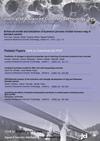定制化学-机械处理再生骨料的实验与分析性能
IF 2
4区 工程技术
Q3 CONSTRUCTION & BUILDING TECHNOLOGY
引用次数: 0
摘要
本研究的目的是评估未经处理的再生骨料(URA)、化学处理的再生骨料(ARA)和定制化学机械处理的再生骨料(AmRA)的实验和分析性能。AmRA (AmRC)组成的混凝土抗压强度、劈裂抗拉强度、抗弯强度、断裂能和弹性模量分别比URA (URC)组成的混凝土高33.88%、5.87%、55.07%、28.84%和50.80%,比ARA (ARC)组成的混凝土高10.89%、21.41%、29.44%、55.33%和34.48%。AmRC的耐磨性分别比URC和ARC高52.03%和43.07%。化学处理降低了粘结在骨料上的砂浆的孔隙率和微裂缝。由于定制的机械处理,表面特征高度均匀和致密。高质量的表面纹理、降低的孔隙率和附着在AmRA上的砂浆中的微裂缝显著加强了界面过渡区。因此,AmRC实现了物理、机械和耐久性性能接近或优于天然骨料(NA)混凝土(NAC)。AmRC与URC、ARC的抗压强度、劈裂抗拉强度、抗弯强度、断裂能、弹性模量之间存在较强的相关性。本研究中最有趣的观察结果是AmRC和NAC的吸附率相当。本研究使用在实验室中破碎混凝土立方体产生的URA。本文章由计算机程序翻译,如有差异,请以英文原文为准。
Experimental and Analytical Performance of Recycled Aggregates Produced by Customized Chemical-Mechanical Treatment
The purpose of this study is to evaluate the experimental and analytical performance of untreated recycled aggregates (URA), chemically treated recycled aggregates (ARA), and customized chemical-mechanically processed recycled aggregates (AmRA). The compressive strength, split tensile strength, flexural strength, fracture energy, and modulus of elasticity of concrete consisting of AmRA (AmRC) are greater than those composed by URA (URC) by 33.88%, 5.87%, 55.07%, 28.84%, and 50.80%, and those of ARA (ARC) by 10.89%, 21.41%, 29.44%, 55.33%, and 34.48%, respectively. AmRC has abrasion resistance around 52.03% and 43.07% higher than URC and ARC. Chemical treatment reduces porosity and microcracks in mortar adhered to aggregate. As a result of the customized mechanical treatment, the surface characteristics are highly uniform and dense. The high-quality surface texture, reduced porosity, and microcracks in the mortar adhering to the AmRA significantly strengthen interfacial transitions zones. Thus, AmRC achieves physical, mechanical, and durability properties close to or superior to natural aggregate (NA) concrete (NAC). Moreover, there is a strong correlation between compressive strength and split tensile strength, flexural strength, fracture energy, and modulus of elasticity of AmRC with URC and ARC. The most interesting observation of the present research is the equivalency in sorptivity of AmRC and NAC. The present study uses the URA produced by crushing concrete cubes in the laboratory.
求助全文
通过发布文献求助,成功后即可免费获取论文全文。
去求助
来源期刊

Journal of Advanced Concrete Technology
工程技术-材料科学:综合
CiteScore
3.70
自引率
10.00%
发文量
45
审稿时长
3.5 months
期刊介绍:
JACT is fast. Only 5 to 7 months from submission to publishing thanks to electronic file exchange between you, the reviewers and the editors.
JACT is high quality. Peer-reviewed by internationally renowned experts who return review comments to ensure the highest possible quality.
JACT is transparent. The status of your manuscript from submission to publishing can be viewed on our website, greatly reducing the frustration of being kept in the dark, possibly for over a year in the case of some journals.
JACT is cost-effective. Submission and subscription are free of charge . Full-text PDF files are available for the authors to open at their web sites.
Scope:
*Materials:
-Material properties
-Fresh concrete
-Hardened concrete
-High performance concrete
-Development of new materials
-Fiber reinforcement
*Maintenance and Rehabilitation:
-Durability and repair
-Strengthening/Rehabilitation
-LCC for concrete structures
-Environmant conscious materials
*Structures:
-Design and construction of RC and PC Structures
-Seismic design
-Safety against environmental disasters
-Failure mechanism and non-linear analysis/modeling
-Composite and mixed structures
*Other:
-Monitoring
-Aesthetics of concrete structures
-Other concrete related topics
 求助内容:
求助内容: 应助结果提醒方式:
应助结果提醒方式:


